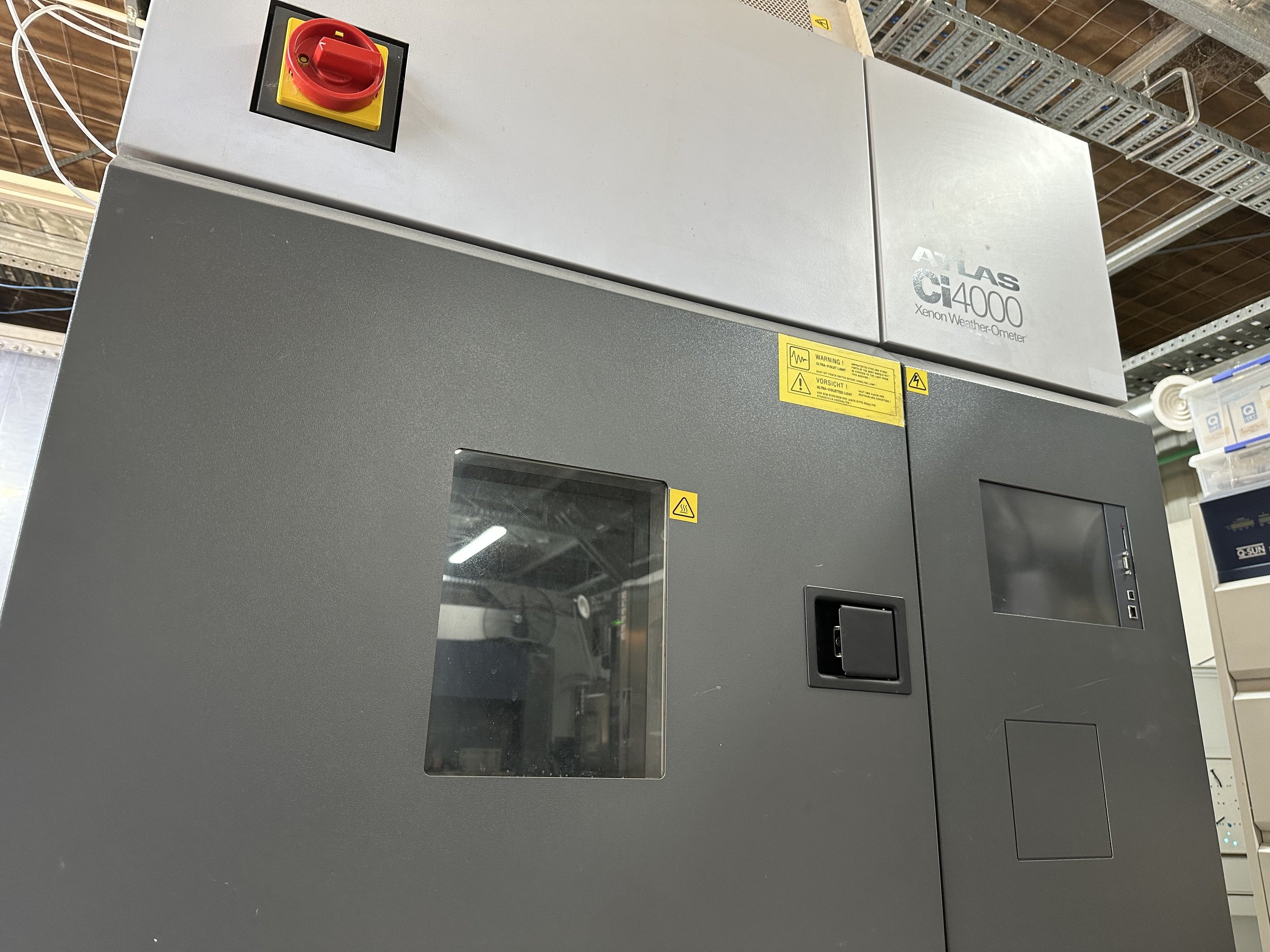UV Testing :: QUV + Xenon-Arc
UV Testing is typically conducted using a Xenon arc or fluorescent tube test chamber, these chambers are made for testing material samples rather than products, however flat and 3D samples can be tested in either chamber type.
We operate three Q-Lab QUV UV testers here in New Zealand, all capable of performing combined UV and condensation cycles with three different bulb types and the QUV/Spray chambers can conduct cold water spray to product thermal shock on the products under test.
Our Q-Lab Q-Sun XE-3H Xenon-Arc chamber is capable of producing full spectrum UV light, with a variety of filters on hand to suit many international standards. The Q-Sun meets ASTM-G155, and MI-STD-810 Solar Radiation standards (and many more) and is most suited to fade / degradation testing.
Last, our Atlas CI4000 rotating drum Xenon-Arc chamber completes the lineup and includes front and back spray, humidity control and more. The chamber is generally used for Automotive samples with long durations or high intensities.
UV Testing Vs Solar Radiation
Solar radiation consists, in addition to UV radiation, of visible light and thermal radiation. In fact, only 5 % of all radiation is UV radiation. UV radiation is the most significant factor in fading colours and mechanical weathering. However, other effects of solar radiation are left out from bare UV test.
UV Testing is typically conducted using a Xenon arc or fluorescent tube test chamber, these chambers typically are made for testing material samples rather than products. The sample size is stipulated at 150mm x 75mm x < 10mm thick and typically you would aim to test at least 5 samples in one lot. 3D samples and products are supported, but please check with us before planning as sizes are limited.
Solar radiation chambers on the other hand are made to accomodate larger samples, and have a slightly different light spectrum and temperature control than xenon arc chambers.
MIL-STD-810 is a common test standard used when applying solar radiation. There are two test methods – cyclic exposure and constant exposure. The duration of the test is determined by the client, we can help to provide advice and benchmarking information if needed.
Typical test durations for MIL-STD-810 solar radiation range from 48 – 500 hours and beyond.
Our QUV Testers
Our Q-Lab QUV/se and QUV/Spray testers can be used to test products to various standards – including ASTM-G154. We maintain a supply of all three lamp types and calibrate our machine using a Q-Lab calibration radiometer.
The QUV/Spray can conduct cycles comprising UV, condensation and cold water spray to simulate thermal shock.
Support for both flat panels (plastics, coatings, samples) and 3-D products is available through our selection of fixtures.
If you’d like more information on how we can help go ahead and contact us.
Our Xenon Arc Q-Sun Tester
Our Q-Lab Q-Sun XE-3H is capable of producing full spectrum UV light, with a variety of filters on hand to suit many international standards. The Q-Sun meets ASTM-G155, and MI-STD-810 Solar Radiation standards (and many more) and is most suited to fade / degradation testing.
This chamber includes temperature and humidity control and we carry a variety of lamp filters including daylight-Q, window-Q, Extended UV and MIL-STD filters.
If you’d like more information on how we can help go ahead and contact us.
Our Atlas CI4000 Tester
Key features of this instrument include: a rotating sample rack to maximize uniformity over all specimens; custom designed nozzles to provide uniform specimen and rack spray; ASTM Black Panel Thermometer or ISO/DIN Black Standard Thermometer to control and monitor temperature at specimen level to ensure test repeatability.
If you’d like more information on how we can help go ahead and contact us.
How many samples should we test?
For UV testing you’ll want at least 5 per inspection point, for solar radiation it really depends on sample availability, as always more is better. One thing to note about both UV and Solar radiation testing is there is no accurate means to calculate field life from the exposure period. MIL-STD-810 attempts to provide guidelines for such a calculation, but in practice the unknowns of the end-use environment tend to derail any attempt to quantify UV or solar radiation damage.
UV Testing is often conducted in batches of hours, for example you might be aiming for 5000 hours total exposure but the test is executed in 1000 hour batches, after which the material is tested or inspected to ensure there is value carrying on. Interim tests might include tensile or compression testing to check the materials physical degradation.
Test Standards
For UV testing the following list summarises some of the available test standards you can apply:
ASTM G154
ASTM G155
ASTM D2565
ASTM D4459
ISO 11341
ISO 4892
ISO 4901
NZTA M29:2023
AS/NZS 1906.3
For Solar Radiation refer to this list:
MIL-STD-810F/G
DIN 75220
GR-487
IEC 60068-2-5
EN 60079-0, Clause 26.10
EN 60945
For further information, or if you have any questions, please contact us here.





